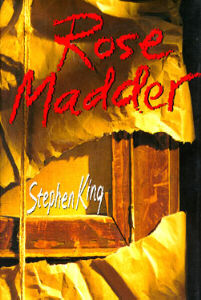Welcome back to Inconstant Reader, the feature column that explores Stephen King’s books in the order they were published — sort of! Containing one of King’s strongest female characters, here’s a book that confirms there are other worlds than these.
WARNING: We don’t want to make you madder, but this article contains spoilers.

‘rose madder‘
noun
- a pigment derived from anthraquinone and hydrated oxide of aluminum, characterized chiefly by its reddish color and permanence: used in painting.
- a horror/fantasy novel by American writer Stephen King, published in 1995

It was happenstance that led me to reading ROSE MADDER so close to 2006’s Lisey’s Story. The current rate of Stephen King adaptations to the screen — and an almost obsessive need to the read the book before the movie or show — has led me to reading some of his books out of order. Yet these books are twins in more ways than one.
Actually, ‘echoes’ of each other is a more accurate statement. While the women who lead the two books are not cosmically connected like Gerald’s Game and Dolores Claiborne, their experiences across space and time form the kind of comfortable parallel that keeps turning up in King’s bibliography. Both are wives of men with violence in their blood, and each woman finds herself walking in a world that is not her own.
On its most basic level, ROSE MADDER is about a woman escaping from an abusive spouse. In 1985, Rosie Daniels is beaten by her husband Norman and miscarries. Due to Norman being a cop, she chooses not to run away. However, nine years later she spots a drop of blood on the sheets from a beating the night before, and she finally makes the decision to leave.
“One miscarriage. One scratched lung. The horrible thing he’d done with the tennis racket.”
After escaping and making her way to a big midwestern town, Rose discovers that she can depend on the kindness of strangers. A kindly man named Peter Slowik directs her to Daughters and Sisters, a women’s shelter that helps her get back on her feet. Rose also trades in her wedding ring for a painting she likes, a powerful image of a woman in a rose madder dress, and begins to date store owner Bill Steiner. Yet Norman isn’t through looking for Rose — and is it possible that the painting is growing?

The narrative is split into two intersecting perspectives from this point. The primary story is of Rose’s new life, her blossoming relationship with Bill and the emotional scarring she continues to live with. Running next to this is an unnerving narrative of Norman hunting Rose, with his violence growing and past crimes coming to light. It’s arguably the most uncomfortable aspect of the book, featuring King’s uncanny ability to get inside the head of his most despicable characters — complete with all the racist, homophobic and misogynistic traits.
Yet Rose is unquestionably one of the best female characters King has written. Her rich interior life is layered and draws on the notion of ‘multiple selves’ that King has played with in several books. Take Mrs. Practical Sensible as an example: while not an active voice like Jessie’s ‘Goody Burlingame’ in Gerald’s Game, the interior persona is a recognition of the code-switching Rose has consciously and unconsciously adopted over the years. Then there’s the more literal other self in ‘Rose Madder,’ the dark rage that lives in the painting and mirrors Rose’s own growing anger.
“Should we rage against ka? No, for ka is the wheel that moves the world, and the man or woman who rages against it will be crushed under its rim.”
Which brings us to the connections with other King works. Boy howdy are there some connections. There’s some minor ones, of course, such as several references to Paul Sheldon’s books as seen in Misery. The contentious appearance of ‘bools’ (later seen in Lisey’s Story) dominate the final act. The entire existence of a secondary plane is reminiscent of The Talisman or The Dark Tower saga, especially given that both the city of Lud and King’s repeated idea of ka (or fate) is mentioned multiple times. For those who have been around the wheel before, you might recall that Cynthia Smith is seen again in Desperation, itself full of connections and threads between King and alter ego Richard Bachman’s other works.
King has often been critical of this work, and in his memoir On Writing he calls ROSE MADDER (along with Insomnia) “not particularly inspiring” and “stiff, trying-too-hard novels.” Far be it for me to disagree with the writer’s intent, but arguably one of the strongest threads of this book is the theme of empowerment. It’s essentially about victims escaping, about “battered women” who “start accepting the blame…for everything.” Yes, it culminates in a potentially on-the-nose ending inspired by Greek mythology (specifically Theseus and the Minotaur), one that’s a heightened set-piece that speaks to King’s cultural influences. Yet Rose is also given the option of forgetting, but chooses to remember everything and move forward anyway. By any definition, that is particularly inspiring.
The ultimate fate of Rose — or ‘Rosie Real’ as she is often called throughout — reflects this. King doesn’t opt for the easy way out, nor does he offer simple solutions and perfectly happy endings. If ka is a wheel, then it has rolled all the way back around for Rose by the final chapter: she inherits Norman’s rage, but releases the seeds of that rage to grow a literal and figurative tree through which she can release it. It’s an ambitious tale of destruction and renewal, and perhaps in these troubling days it’s the book that found me at the right time and place.
Next time, Inconstant Reader takes a long walk down 1996’s The Green Mile, a serial novel released over the course of six months. While you’re here, go check out Batrock.net, where my buddy Alex Doenau is running through this Stephen King adventure with me.





